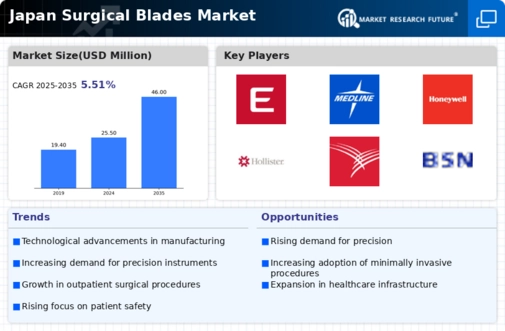Rising Surgical Procedures
The increasing number of surgical procedures in Japan is a primary driver for the surgical blades market. As the population ages, the demand for surgical interventions rises, leading to a greater need for surgical instruments, including blades. In 2025, it is estimated that the number of surgeries performed in Japan will reach approximately 10 million annually, reflecting a growth of around 5% from previous years. This surge in surgical activity necessitates a consistent supply of high-quality surgical blades, thereby propelling market growth. Furthermore, advancements in minimally invasive surgical techniques are likely to increase the variety of blades required, as different procedures may necessitate specialized designs. Consequently, the surgical blades market is poised to benefit from this upward trend in surgical procedures.
Expansion of Healthcare Infrastructure
The expansion of healthcare infrastructure in Japan is a significant driver for the surgical blades market. As the government invests in upgrading hospitals and surgical centers, the demand for surgical instruments, including blades, is expected to rise. In 2025, the healthcare expenditure in Japan is projected to reach approximately ¥50 trillion, reflecting a commitment to improving healthcare services. This investment is likely to result in the establishment of new surgical facilities, which will require a substantial supply of surgical blades. Additionally, the growing trend of private healthcare facilities may further contribute to market growth, as these establishments often seek to provide high-quality surgical services. Consequently, the surgical blades market is poised to benefit from the ongoing expansion of healthcare infrastructure in Japan.
Growing Awareness of Infection Control
The heightened awareness of infection control in surgical settings significantly influences the surgical blades market. In Japan, healthcare facilities are increasingly adopting stringent infection prevention protocols, which include the use of single-use surgical blades. This trend is driven by the need to minimize the risk of cross-contamination and ensure patient safety. As a result, the demand for disposable surgical blades is projected to grow, potentially accounting for over 60% of the market share by 2025. Additionally, hospitals and surgical centers are investing in training programs for staff to emphasize the importance of using sterile instruments, further supporting the shift towards disposable options. This growing focus on infection control is likely to reshape the surgical blades market, as manufacturers adapt their product offerings to meet these evolving standards.
Regulatory Support for Medical Devices
Japan's regulatory environment plays a crucial role in shaping the surgical blades market. The Pharmaceuticals and Medical Devices Agency (PMDA) has established stringent guidelines that ensure the safety and efficacy of medical devices, including surgical blades. This regulatory support fosters innovation and encourages manufacturers to invest in the development of advanced surgical blades. In 2025, the market is expected to witness a rise in the introduction of new products that comply with these regulations, enhancing the overall quality of surgical instruments. Moreover, the PMDA's efforts to streamline the approval process for innovative medical devices may further stimulate market growth. As a result, the surgical blades market is likely to experience an influx of new technologies and designs, catering to the evolving needs of healthcare professionals.
Technological Innovations in Manufacturing
Technological advancements in manufacturing processes are transforming the surgical blades market. In Japan, manufacturers are increasingly adopting automation and precision engineering techniques to enhance the quality and consistency of surgical blades. These innovations not only improve production efficiency but also reduce costs, making high-quality blades more accessible to healthcare providers. By 2025, it is anticipated that the surgical blades market will see a rise in the adoption of advanced materials and coatings that enhance blade performance and longevity. Furthermore, the integration of digital technologies in design and manufacturing processes may lead to the development of customized surgical blades tailored to specific surgical procedures. This focus on innovation is likely to drive competition among manufacturers, ultimately benefiting the surgical blades market.

















Leave a Comment